Endogenous analgesia mediated by CD4(+) T lymphocytes is dependent on enkephalins in mice
- PMID: 27245576
- PMCID: PMC4888630
- DOI: 10.1186/s12974-016-0591-x
Endogenous analgesia mediated by CD4(+) T lymphocytes is dependent on enkephalins in mice
Abstract
Background: T cell-derived opioids play a key role in the control of inflammatory pain. However, the nature of opioids produced by T cells is still matter of debate in mice. Whereas β-endorphin has been found in T lymphocytes by using antibody-based methods, messenger RNA (mRNA) quantification shows mainly mRNA encoding for enkephalins. The objective of the study is to elucidate the nature of T cell-derived opioids responsible for analgesia and clarify discrepancy of the results at the protein and genetic levels.
Methods: CD4(+) T lymphocytes were isolated from wild-type and enkephalin-deficient mice. mRNA encoding for β-endorphin and enkephalin was quantified by RT-qPCR. The binding of commercially available polyclonal anti-endorphin antibodies to lymphocytes from wild-type or enkephalin knockout mice was assessed by cytofluorometry. Opioid-mediated analgesic properties of T lymphocytes from wild-type and enkephalin-deficient mice were compared in a model of inflammation-induced somatic pain by measuring sensitivity to mechanical stimuli using calibrated von Frey filaments.
Results: CD4(+) T lymphocytes expressed high level of mRNA encoding for enkephalins but not for β-endorphin in mice. Anti-β-endorphin polyclonal IgG antibodies are specific for β-endorphin but cross-react with enkephalins. Anti-β-endorphin polyclonal antibodies bound to wild-type but not enkephalin-deficient CD4(+) T lymphocytes. Endogenous regulation of inflammatory pain by wild-type T lymphocytes was completely abolished when T lymphocytes were deficient in enkephalins. Pain behavior of immune-deficient (i.e., without B and T lymphocytes) mice was superimposable to that of mice transferred with enkephalin-deficient lymphocytes.
Conclusions: Rabbit polyclonal anti-β-endorphin serum IgG bind to CD4(+) T lymphocytes because of their cross-reactivity towards enkephalins. Thus, staining of T lymphocytes by anti-β-endorphin polyclonal IgG reported in most of studies in mice is because of their binding to enkephalins. In mice, CD4(+) T lymphocytes completely lose their analgesic opioid-mediated activity when lacking enkephalins.
Keywords: Enkephalin; Inflammation; Pain; T lymphocytes; β-endorphin.
Figures

 ) or β-endorphin (
) or β-endorphin ( )
)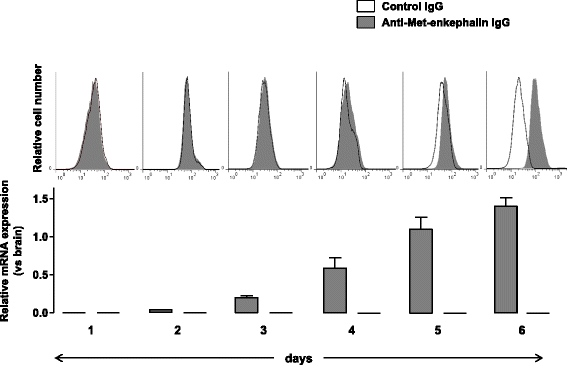
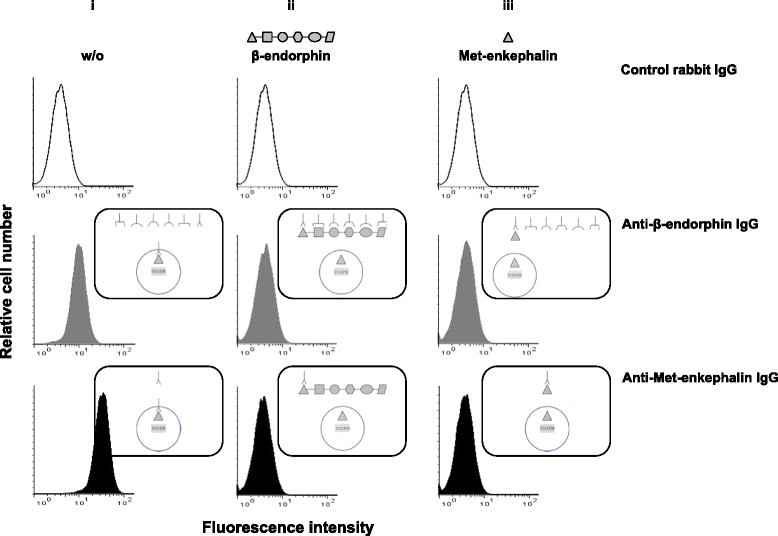
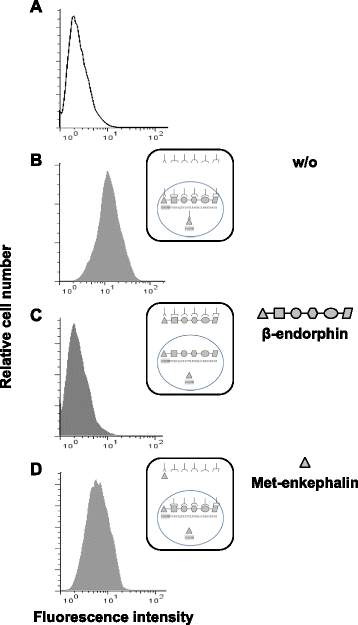
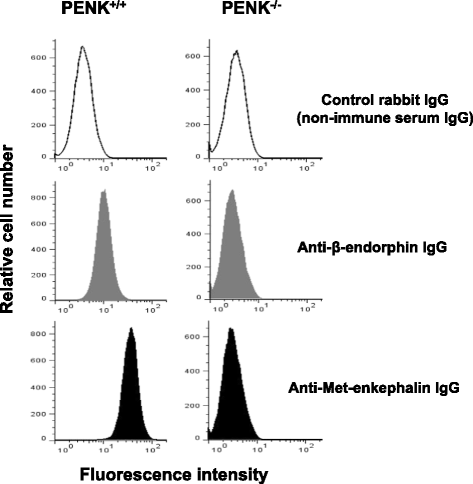
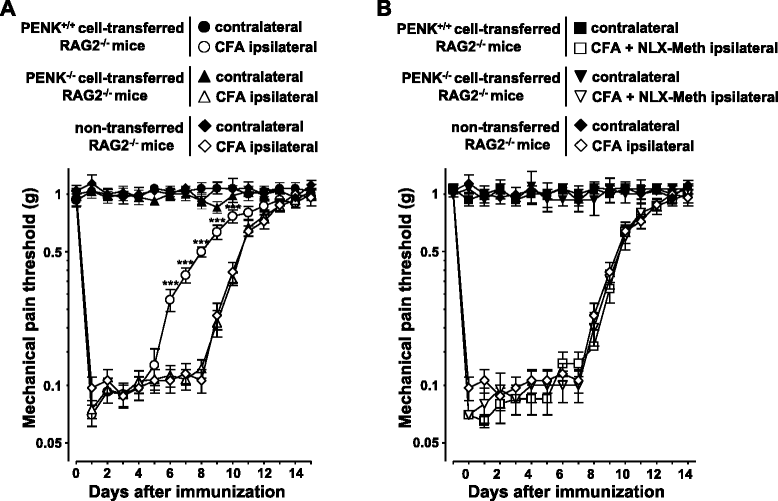
Similar articles
-
T-lymphocyte-derived enkephalins reduce Th1/Th17 colitis and associated pain in mice.J Gastroenterol. 2018 Feb;53(2):215-226. doi: 10.1007/s00535-017-1341-2. Epub 2017 Apr 19. J Gastroenterol. 2018. PMID: 28424989
-
Immune conditions associated with CD4+ T effector-induced opioid release and analgesia.Pain. 2012 Feb;153(2):485-493. doi: 10.1016/j.pain.2011.11.013. Epub 2011 Dec 19. Pain. 2012. PMID: 22188867
-
Stress-induced analgesia and endogenous opioid peptides: the importance of stress duration.Eur J Pharmacol. 2011 Jan 15;650(2-3):563-7. doi: 10.1016/j.ejphar.2010.10.050. Epub 2010 Oct 31. Eur J Pharmacol. 2011. PMID: 21044625 Free PMC article.
-
Immune-derived opioids and peripheral antinociception.Clin Exp Pharmacol Physiol. 2001 Mar;28(3):230-2. doi: 10.1046/j.1440-1681.2001.03425.x. Clin Exp Pharmacol Physiol. 2001. PMID: 11236131 Review.
-
Opioid peptide receptors and membrane biology.Prog Clin Biol Res. 1982;97:113-35. Prog Clin Biol Res. 1982. PMID: 6296876 Review.
Cited by
-
Proinflammatory Markers, Chemokines, and Enkephalin in Patients Suffering from Dry Eye Disease.Int J Mol Sci. 2018 Apr 17;19(4):1221. doi: 10.3390/ijms19041221. Int J Mol Sci. 2018. PMID: 29673232 Free PMC article.
-
Immune Actions on the Peripheral Nervous System in Pain.Int J Mol Sci. 2021 Feb 1;22(3):1448. doi: 10.3390/ijms22031448. Int J Mol Sci. 2021. PMID: 33535595 Free PMC article. Review.
-
The Chemokine CCL4 (MIP-1β) Evokes Antinociceptive Effects in Mice: a Role for CD4+ Lymphocytes and Met-Enkephalin.Mol Neurobiol. 2019 Mar;56(3):1578-1595. doi: 10.1007/s12035-018-1176-8. Epub 2018 Jun 15. Mol Neurobiol. 2019. PMID: 29907903
-
Opioids and the immune system - friend or foe.Br J Pharmacol. 2018 Jul;175(14):2717-2725. doi: 10.1111/bph.13750. Epub 2017 Mar 23. Br J Pharmacol. 2018. PMID: 28213891 Free PMC article. Review.
-
Delta opioid receptors on nociceptive sensory neurons mediate peripheral endogenous analgesia in colitis.J Neuroinflammation. 2022 Jan 6;19(1):7. doi: 10.1186/s12974-021-02352-3. J Neuroinflammation. 2022. PMID: 34991641 Free PMC article.
References
Publication types
MeSH terms
Substances
LinkOut - more resources
Full Text Sources
Other Literature Sources
Medical
Research Materials

